Duiker W.J., Spielvogel J.J. The Essential World History. Volume 1: To 1800
Подождите немного. Документ загружается.

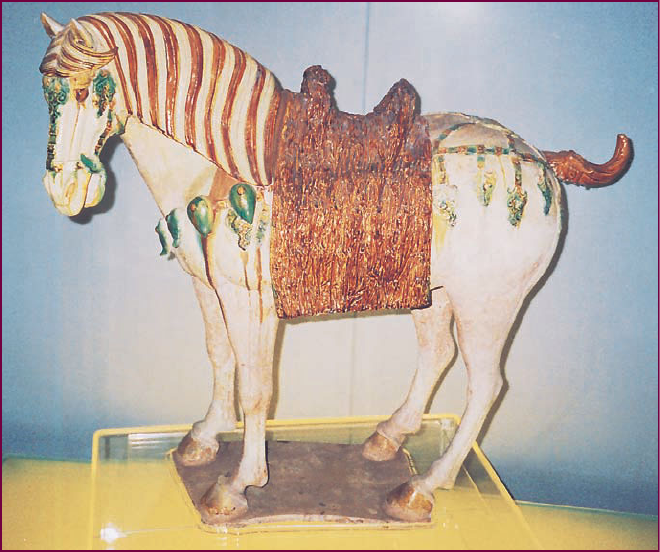
The Maritime Route The Silk Road was so hazardous
that shipping goods by sea became increasingly popular.
China had long been engaged in sea trade with other
countries in the region, but most of the commerce was
originally in the hands of Korean, Japanese, or Southeast
Asian merchants. Chinese maritime trade, however, was
stimulated by the invention of the compass and technical
improvements in shipbuilding such as the sternpost
rudder and the lug sail (which enabled ships to sail close
to the wind). If Marco Polo’s observations can be be-
lieved, by the thirteenth century, Chinese junks (a type of
seagoing ship with square sails and a flat bottom that was
popular in Asian waters) had multiple sails and were up
to 2,000 tons in size, much larger than contemporary
ships in the West. The Chinese governor of Canton in the
early twelfth century remarked:
According to the government regulations concerning seagoing
ships, the larger ones can carry several hundred men, and
the smaller ones may have more than a hundred men on
board. ... The ship’s pilots are acquainted with the configu-
ration of the coasts; at nig ht they steer by the stars, and in
the daytime by the Sun. In dark weather they look at the
south-pointing needle. They also use
a line a hundred feet long with a hook
at the end, which they let down to
take samples of mud from the sea-
bottom; by its appearance and smell
they can determine their whereabouts.
3
A wide variet y of goods passed
through Chinese por ts. The Chinese
exported tea, silk, and porcelain to
the countries beyond the South
China Sea, receiving exotic woods,
precious stones, and various tropical
goods in exchange. Seapor ts on
the southern China coast expor ted
sweet oranges, lemons, and peaches
in return for grapes, walnuts, and
pomegranates. Along the Silk Road
to China came raw hides, furs,
and horses. Chinese aristocrats,
their appetite for material con-
sumption stimulated by the afflu-
ence of Chinese society during
much of the Tang and Song periods,
were fascinated by the exotic goods
and the flora and fauna of the desert
and the tropical lands of the South
Seas. The city of Chang’an became
the eastern terminus of the Silk
Road and perhaps the wealthiest cit y
in the world during the Tang era.
The major port of exit in southern
China was Canton, where an estimated 100,000 mer-
chants lived.
Some of this trade was a product of the tribute sys-
tem, which the Chinese rulers used as an element of their
foreign policy. The Chinese viewed the outside world as
they viewed their own society---in a hierarchical manner.
Rulers of smaller countries along the periphery were
viewed as ‘‘younger brothers’’ of the Chinese emperor and
owed fealty to him. Foreign rulers who accepted the re-
lationship were required to pay tribute and to promise
not to harbor enemies of the Chinese Empire. In return,
they obtained legitimacy and access to the vast Chinese
market.
Society in Traditiona l China
These political and economic changes affected Chinese
society during the Tang and Song eras. For one thing, it
became much more complex. Whereas previously China
had been almost exclusively rural, with a small urban class
of merchants, artisans, and workers almost entirely de-
pendent on the state, the cities had now grown into an
ATangHorse. During the Tang dynasty, trade between China, India, and the Middle East along
the famous Silk Road increased rapidly and introduced new Central Asian motifs to Chinese culture.
Ceramic representations of the sturdy Central Asian horse and the two-humped Bactrian camel were
often produced as decorative objects for the homes of the wealthy or as tomb figures. Preserved for us
today, these ceramic studies of horses and camels, as well as of officials, court ladies, and servants,
painted in brilliant gold, green, and blue lead glazes, are impressive examples of Tang cultural
achievement.
c
Claire L. Duiker
244 CHAPTER 10 THE FLOWERING OF TRADITIONAL CHINA
important, if statistically still insignificant, part of the
population. Urban life, too, had changed. Cities were no
longer primarily administrative centers dominated by
officials and their families but now included a much
broader mix of officials, merchants, artisans, touts, and
entertainers. Unlike the situation in Europe, however,
Chinese cities did not possess special privileges that
protected their residents from the rapacity of the central
government.
In the countryside, equally significant changes were
taking place, as the relatively rigid demarcation between
the landed aristocracy and the mass of the rural popu-
lation gave way to a more complex mixture of landed
gentry, free farmers, sharecroppers, and landless laborers.
There was also a class of ‘‘base people,’’ consisting of ac-
tors, butchers, and prostitutes, who possessed only lim-
ited legal rights and were not permitted to take the civil
service examination.
The Rise of the Gentry Perhaps the most significant
development was the rise of the landed gentry as the most
influential force in Chinese society. The gentry class
controlled much of the wealth in the rural areas and
produced the majority of the candidates for the bureau-
cracy. By virtue of their possession of land and specialized
knowledge of the Confucian classics, the gentry had re-
placed the aristocracy as the political and economic elite
of Chinese society. Unlike the aristocracy, however, the
gentry did not form an exclusive class separated by an
accident of birth from the remainder of the population.
Upward and downward mobility between the scholar-
gentry class and the remainder of the population was not
uncommon and may have been a key factor in the sta-
bility and longevity of the system. A position in the bu-
reaucracy opened the doors to wealth and prestige for the
individual and his family but was no guarantee of success,
and the fortunes of individual families might experience a
rapid rise and fall. The soaring ambitions and arrogance
of China’s landed gentry are vividly described in the
following wish list set in poetry by a young bridegroom of
the Tang dynasty:
Chinese slaves to take charge of treasury and barn,
Foreign slaves to take care of my cattle and sheep.
Strong-legged slaves to run by saddle and stirrup
when I ride,
Powerful slaves to till the fields with might and main,
Handsome slaves to play the harp and hand the wine;
Slim-waisted slaves to sing me songs, and dance;
Dwarfs to hold the candle by my dining-couch.
4
For affluent Chinese in this era, life offered many
more pleasures than had been available to their ancestors.
There were new forms of entertainment, such as playing
cards and chess (brought from India, although an early
form had been invented in China during the Zhou dy-
nasty); new forms of transportation, such as the paddle-
wheel boat and horseback riding (made possible by the
introduction of the stirrup); better means of communi-
cation (block printing was first invented in the eighth
century
C.E.); and new tastes for the palate introduced
from lands beyond the frontier. Tea had been introduced
from the Burmese frontier by monks as early as the Han
dynasty, and brandy and other concentrated spirits pro-
duced by the distillation of alcohol made their appearance
in the seventh century.
Village China The vast majority of the Chinese people
still lived off the land in villages ranging in size from a few
dozen residents to several thousand. The life of the
farmers was bounded by their village. Although many
communities were connected to the outside world by
roads or rivers, the average Chinese rarely left the confines
of their native village except for an occasional visit to a
nearby market town.
An even more basic unit than the village in the lives
of most Chinese, of course, was the family. The ideal was
the joint family with at least th ree generations under one
roof. Because of the heavy labor requirements of rice
farming, the tradition of the joint family was especially
prevalent in the south. When a son married, he was
expected to bring his new wife back to live in his par-
ents’ home.
Chinese village architecture reflected these traditions.
Most family dwellings were simple, consisting of one or at
most two rooms. They were usually constructed of dried
mud, stone, or brick, depending on available materials
and the prosperity of the family. Roofs were of thatch or
tile, and the floors were usually of packed dirt. Large
houses were often built in a square around an inner
courtyard, thus guaranteeing privacy from the outside
world.
Within the family unit, the eldest male theoretically
ruled as an autocrat. He was responsible for presiding
over ancestral rites at an altar, usually in the main room
of the house. He had traditional legal rights over his wife,
and if she did not provide him with a male heir, he was
permitted to take a second wife. She, however, had no
recourse to divorce. As the old saying went, ‘‘Marry a
chicken, follow the chicken; marry a dog, follow the dog.’’
Wealthy Chinese might keep concubines, who lived in a
separate room in the house and sometimes competed
with the legal wife for precedence.
In accordance with Confucian tradition, children
were expected, above all, to obey their parents, who not
only determined their children’s careers but also selected
CHINA REUNIFIED:THE SUI, THE TANG, AND THE SONG 245

their marriage partners. Filial piety was viewed as an
absolute moral good, above virtually all other moral
obligations.
The Role of Women The tradition of male superiority
continued from ancient times into the medieval era, es-
pecially under the southern Song when it was reinforced
by neo-Confucianism (see the box above). Female chil-
dren were considered less desirable than males because
they could not undertake heavy work in the fields or carry
on the family traditions. Poor families often sold their
daughters to wealthy villagers to serve as concubines, and
in times of famine, female infanticide was not uncommon
to ensure that there would be food for the remainder of
the family. Concubines had few legal rights; female do-
mestic servants, even fewer.
During the Song era, two new practices emerged that
changed the equation for women seeking to obtain a
successful marriage contract. First, a new form of dowry
appeared. Whereas previously the prospective husband
offered the bride’s family a bride price, now the reverse
became the norm, with the bride’s parents paying the
groom’s family a dowry. With the prosperity that char-
acterized Chinese society during much of the Song era,
affluent parents sought to buy a satisfactory husband for
their daughter, preferably one with a higher social
standing and good prospects for an official career.
A second source of marital bait during the Song
period was the promise of a bride w ith tiny bound feet.
The process of foot binding, carried out on girls aged five
to thirteen, was excruciatingly painful, since it bent and
compressed the foot to half its normal size by impris-
oning it in restrictive bandages. But the procedure was
often performed by ambitious mothers intent on assuring
their daughters of the best possible prospects for mar-
riage. Bound feet represented submissiveness and self-
discipline, two required attributes for the ideal Confucian
wife.
THE SAINTLY MISS WU
The idea that a wife should sacrifice her wants to
the needs of her husband and family was deeply
embedded in traditional Chinese society. Widows
in particular had few rights, and their remarriage
was strongly condemned. In this account from a story by Hung
Mai, a twelfth-century writer, the widowed Miss Wu wins the
respect of the entire community by faithfully serving her
mother-in-law.
Hung Mai, A Song Family Saga
Miss Wu served her mother-in-law very filially. Her mother-in-law
had an eye ailment and felt sorry for her daughter-in-law’s solitary
and poverty-stricken situation, so suggested that they call in a son-
in-law for her and thereby get an adoptive heir. Miss Wu announced
in tears, ‘‘A woman does not serve two husbands. I will support you.
Don’t talk this way.’’ Her mother-in-law, seeing that she was deter-
mined, did not press her. Miss Wu did spinning, washing, sewing,
cooking, and cleaning for her neighbors, earning perhaps a hundred
cash a day, all of which she gave to her mother-in-law to cover the
cost of firewood and food. If she was given any meat, she would
wrap it up to take home. ...
Once when her mother-in-law was cooking rice, a neighbor
called to her, and to avoid overcooking the rice she dumped it into
a pan. Owing to her bad eyes, however, she mistakenly put it in the
dirty chamber pot. When Miss Wu returned and saw it, she did not
say a word. She went to a neighbor to borrow some cooked rice for
her mother-in-law and took the dirty rice and washed it to eat
herself.
One day in the daytime neighbors saw [Miss Wu] ascending
into the sky amid colored clouds. Startled, they told her mother-in-
law, who said, ‘‘Don’t be foolish. She just came back from pounding
rice for someone, and is lying down on the bed. Go and look.’’ They
went to the room and peeked in and saw her sound asleep. Amazed,
they left.
When Miss Wu woke up, her mother-in-law told her what hap-
pened, and she said, ‘‘I just dreamed of two young boys in blue
clothes holding documents and riding on the clouds. They grabbed
my clothes and said the Emperor of Heaven had summoned me.
They took me to the gate of heaven and I was brought in to see the
emperor, who was seated beside a balustrade. He said ‘Although you
are just a lowly ignorant village woman, you are able to serve your
old mother-in-law sincerely and work hard. You really deserve re-
spect.’ He gave me a cup of aromatic w ine and a string of cash, say-
ing, ‘I will supply you. From now on you will not need to work for
others.’ I bowed to thank him and came back, accompanied by the
two boys. Then I woke up.’’
There was in fact a thousand cash on the bed, and the room was
filled with a fragrance. They then realized that the neighbors’ vision
had been a spirit journey. From this point on even more people asked
her to work for them, and she never refused. But the money that had
been given to her she kept for her mother-in-law’s use. Whatever they
used promptly reappeared, so the thousand cash was never exhausted.
The mother-in-law also regained her sight in both eyes.
Q
What is the moral of this story? How do the supernatural
elements in the account strengthen the lesson intended by the
author?
246 CHAPTER 10 THE FLOWERING OF TRADITIONAL CHINA
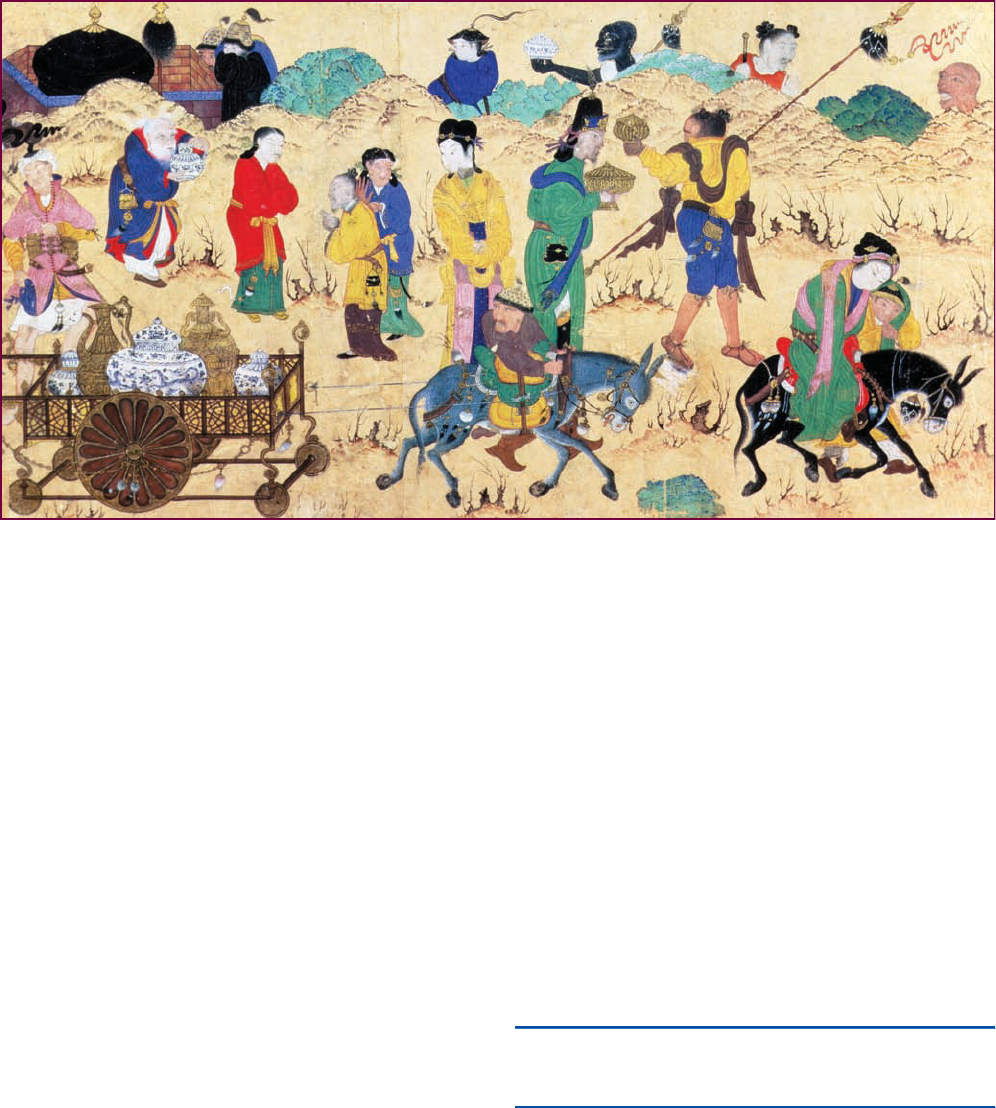
Throughout northern China, foot binding became a
common practice for women of all social classes. It was
less common in southern China, where the cultivation of
wet rice could not be carried out with bandaged feet;
there it tended to be limited to the scholar-gentry class.
Still, most Chinese women with bound feet contributed
to the labor force to supplement the family income. Al-
though foot binding was eventually prohibited, the
practice lasted into the twentieth century, particularly in
rural villages.
As in most traditional societies, there were exceptions
to the low status of women in Chinese society. Women
had substantial property rights and retained control over
their dowries even after divorce or the death of the hus-
band. Wives were frequently an influential force within
the home, often handling the accounts and taking pri-
mary responsibility for raising the children. Some were
active in politics. The outstanding example was Wu Zhao
(c. 625--c. 706), popularly known as Empress Wu. Se-
lected by Emperor Tang Taizong as a concubine, after his
death she rose to a position of supreme power at court.
At first, she was content to rule through her sons, but in
690, she declared herself empress of China. For her
presumption, she has been vilified by later Chinese his-
torians, but she was actually a quite capable ruler. She was
responsible for giving meaning to the civil serv ice ex-
amination system and was the first to select graduates of
the examinations for the highest positions in government.
During her last years, she reportedly fell under the in-
fluence of courtiers and was deposed in 705, when she
was probably around eighty.
Explosion in Central Asia:
The Mongol Empire
Q
Focus Question: Why were the Mongols able to amass
an empire, and what were the main characte ristics of
their rule in China?
The Mongols, who suc c eeded the Song as the rulers of
China in 1279, rose to power in Asia with stunning ra-
pidity. When Genghis Khan (also known as Chinggis
Khan), the founder of Mongol greatness, was born, the
Mongols were a relatively obscure pastoral people in
the region of modern Outer Mongolia. Like most of the
A Young Chinese Bride and Her Dowry. A Chinese bride had to leave her parental home for that of
her husband, transferring her filial allegiance to her in-laws. For this reason, the mother-son relationship would
be the most important one in a Chinese woman’s life. With the expansion of the gentry class during the Song
dynasty, young men who passed the civil service examination became the most sought-after marriage prospects,
requiring that the families of young women offer a substantial dowry as an enticement to the groom’s family.
But some women were destined for more distant locations. In this Persian miniature, a Chinese bride who is to
marry a Turkish bridegroom leads a procession along the Silk Road, transporting her dowry of prized Chinese
porcelain to her new home.
c
The Art Archive/Topkapi Museum/Gianni Dagli Orti
EXPLOSION IN CENTRAL ASIA:THE MONGOL EMPIRE 247
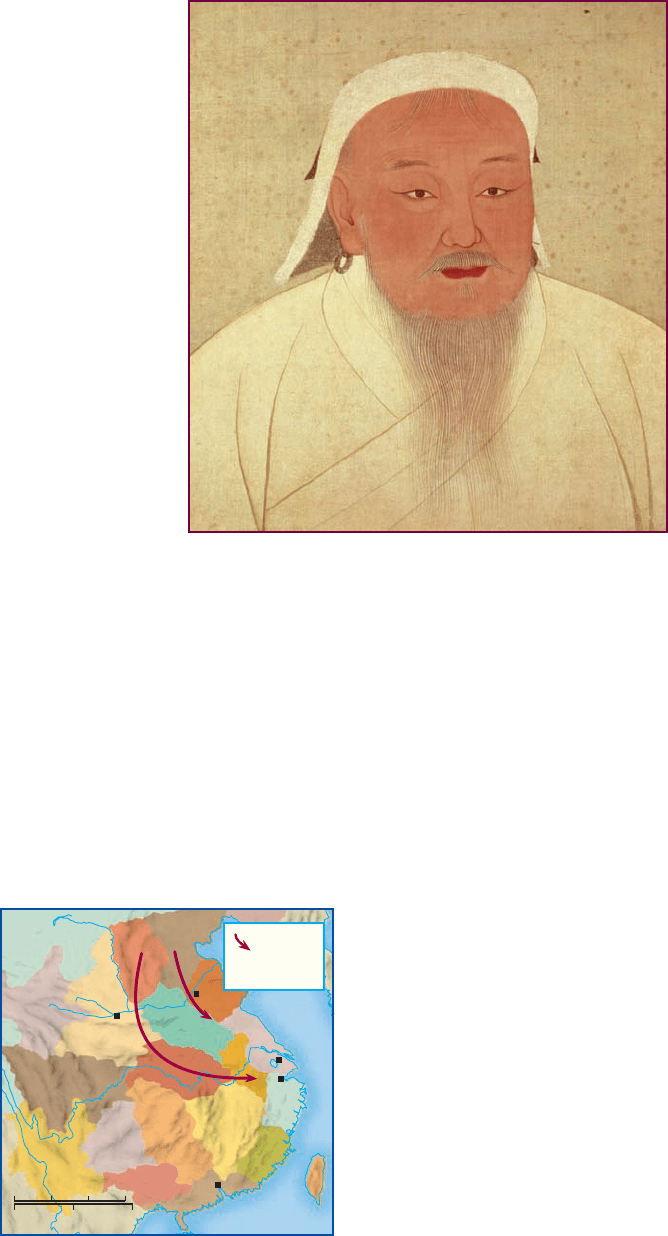
nomadic peoples in the region, they wer e organ ized loosely
into clans and tribes and even lack ed a common na me for
themselves. Rivalry among the various tribes over pasture,
livestock, and booty was in tense and inc r eased at th e en d
of the twelfth century as a result of a growing population
and the consequent overgrazing of pastures.
This challenge was met by the great Mongol chieftan
Genghis Khan. Bo rn during the 1160s, Genghis Khan,
whose original name was Temuchin (or Temujin), was the
son of an impoverished noble of his tribe. When Te-
muchin was still a child, his father was murdered by a
rival, and the boy was forced to seek refuge in the wil-
derness. Described by one historian as tall, adroit, and
vigorous, young Temuchin gradually unified the Mongol
tribes through his prowess and the power of his
personality. In 1206, he was el ected Genghis Khan (‘‘uni-
versal ruler’’) at a massive tribal meeting in the Gobi
Desert. From that time on, he devoted himself to military
pursuits. Mongol nomads were now forced to pay taxes
and were subject to military conscription. ‘‘Man’s highest
joy,’’ Genghis Khan reportedly remarked, ‘‘is in victory: to
conquer one’s enemies, to pursue them, to deprive them of
their possessions, to make their beloved weep, to ride on
their horses, and to embrace th eir wives and daughters.’’
5
The army that Genghis Khan unleashed on the world
was not exceptionally large---totaling less than 130,000 in
1227, at a time when the total Mongol population
numbered between one and two million. But their mas-
tery of military tactics set the Mongols apart from their
rivals. Their tireless flying columns of mounted warriors
surrounded their enemies like cattle and harassed them,
luring them into pursuit and then ambushing them with
flank attacks.
In the years after the election of Temuchin as uni-
versal ruler, the Mongols defeated tribal groups to their
west and then turned their attention to the seminomadic
non-Chinese kingdoms of northern China. There they
discovered that their adversaries
were armed with a weapon called a
firelance, an early form of flame-
thrower. Gunpowder had been in-
vented in China during the late Tang
period, and by the early thirteenth
century, a firelance had been devel-
oped that could spew out flames
and projectiles a distance of 30 or
40 yards, inflicting considerable
damage on the enemy.
Before the end of the thirteenth
century, the firelance had evolved
into the much more effective
handgun and cannon. These in-
ventions came too late to save China
from the Mongols, however, and were transmitted to
Europe by the early fourteenth century by foreigners
employed by the Mongol rulers of China.
While some Mongol armies were engaged in the
conquest of northern China, others traveled farther afield
and advanced as far as central Europe. Only the death of
Genghis Khan in 1227 may have prevented an all-out
Mongol attack on western Europe
(see the box on p. 249). In 1231, the
Mongols attacked Persia and then
defeated the Abbasids at Baghdad in
1258 (see Chapter 7). Mongol forces
attacked the Song from the west in
the 1260s and finally defeated the
remnants of the Song navy in 1279.
By then, the Mongol Empire
was quite different from what it had
been under its founder. Prior to the
conquests of Genghis Khan, the
Mongols had been purely nomadic.
They spent their winters in the
southern plains, where they found
suitable pastures for their cattle,
750 Kilometers
500 Miles
500250
250
0
0
South China Sea
Chang’an
Kaifeng
Hangzhou
Suzhou
Y
e
l
l
o
w
R
.
SOUTHERN
SONG
Canton
Y
a
n
g
t
z
e
R
.
Path of
Mongol
advance
The Mongol Conquest of China
Genghis Khan. Founder of the Mongol Empire, Temuchin (later to
be known as Genghis Khan) died in 1227, long before Mongol warriors
defeated the armies of the Song in China and established the Yuan dynasty
(1279–1368). In this portrait by a Chinese court artist, the ruler appears in
a stylized version, looking much like other Chinese emperors of the period.
Painters in many societies used similar techniques to render their subjects
in a manner familiar to prospective observers.
c
National Palace Museum, Taipei/ The Bridgeman Art Library
248 CHAPTER 10 THE FLOWERING OF TRADITIONAL CHINA

and traveled north in the summer to wooded areas
where the water was sufficient. They lived in round, felt-
covered tent s (called yurts), which were lightly con-
structed so that they could be easily transported. For
food, the Mongols depended on milk and meat from
their herds and game from hunting.
To administer the new empire, Genghis Khan had set
up a capital city at Karakorum, in present-day Outer
Mongolia, but prohibited his fellow Mongols from
practicing sedentary occupations or living in cities. But
under his successors, the Mongols began to adapt to their
conquered areas. As one khan remarked, quoting his
Chinese adviser, ‘‘Although you inherited the Chinese
Empire on horseback, you cannot rule it from that po-
sition.’’ Mongol aristocrats began to enter administrative
positions, while commoners took up sedentary occupa-
tions as farmers or merchants.
6
The territorial nature of the empire also changed.
Following tribal custom, at the death of the ruling khan,
the territory was distributed among his heirs. The once-
united empire of Genghis Khan was thus divided into
several separate khanates, each under the autonomous
rule of one of his sons by his principal wife. One of his
sons was awarded the khanate of Chaghadai in Central
Asia with its capital at Samarkand; another ruled Persia
from the conquered city of Baghdad; a third took charge
of the khanate of Kipchak (commonly known as the
Golden Horde). But it was one of his grandsons, named
Khubilai Khan (1215--1294), who completed the con-
quest of the Song and established a new Chinese dynasty,
called the Yuan (from a phrase in the Book of Changes
referring to the ‘‘original creative force’’ of the universe).
Khubilai moved the capital of China northward from
Hangzhou to Khanbaliq (‘‘city of the khan’’), which was
located on a major trunk route from the Great Wall to the
plains of northern China (see Map 10.2). Later the city
would be known by the Chinese name Beijing, or Peking
(‘‘northern capital’’).
ALETTER TO THE POPE
In 1243, Pope Innocent IV dispatche d the Franciscan
friar John Plano Carpini to the Mongol headquar-
ters at Karakorum to appeal to the great khan
Kuyuk to cease his attacks on Christians. After a
considerable wait, Carpini was given the following reply, which
could not have pleased the pope. The letter was discovered
recently in the Vatican archives.
A Letter from Kuyuk Khan to Pope Innocent IV
By the power of the Eternal Heaven, We are the all-embracing Khan
of all the Great Nations. It is our command:
This is a decree, sent to the great Pope that he may know and
pay heed.
After holding counsel with the monarchs under your suzerainty,
you have sent us an offer of subordination, which we have accepted
from the hands of your envoy.
If you should act up to your word, then you, the great Pope,
should come in person wi th the monarchs to pay us homage and
we should thereupon instruct you concerning the commands of
the Yasak.
Furthermore, you have said it would be well for us to become
Christians. You write to me in person about this matter, and have
addressed to me a request. This, your request, we cannot under-
stand. Furthermore, you have written me these words: ‘‘You have
attacked all the territories of the Magyars and other Christians, at
which I am astonished. Tell me, what was their crime?’’ These, your
words, we likewise cannot understand. Jenghiz Khan and Ogatai
Khakan revealed the commands of Heaven. But those whom you
name would not believe the commands of Heaven. Those of whom
you speak showed themselves highly presumptuous and slew our
envoys. Therefore, in accordance with the commands of the Eternal
Heaven the inhabitants of the aforesaid countries have been slain
and annihilated. If not by the command of Heaven, how can anyone
slay or conquer out of his own strength?
And when you say: ‘‘I am a Christian. I pray to God. I arraign
and despise others,’’ how do you know who is pleasing to God and
to whom He allots His grace? How can you know it, that you speak
such words?
Thanks to the power of the Eternal Heaven, all lands have been
given to us from sunrise to sunset. How could anyone act other
than in accordance with the commands of Heaven? Now your own
upright heart must tell you: ‘‘We will become subject to you, and
will place our powers at your disposal.’’ You in person, at the head
of the monarchs, all of you, without exception, must come to tender
us service and pay us homage, then only will we recognize your sub-
mission. But if you do not obey the commands of Heaven, and run
counter to our orders, we shall know that you are our foe.
That is what we have to tell you. If you fail to act in accor-
dance therewith, how can we foresee what will happen to you?
Heaven alone knows.
Q
Based on this selection, what message was the pope
seeking to convey to the great khan in Karakorum? What was
the nature of the latter’s reply?
EXPLOSION IN CENTRAL ASIA:THE MONGOL EMPIRE 249
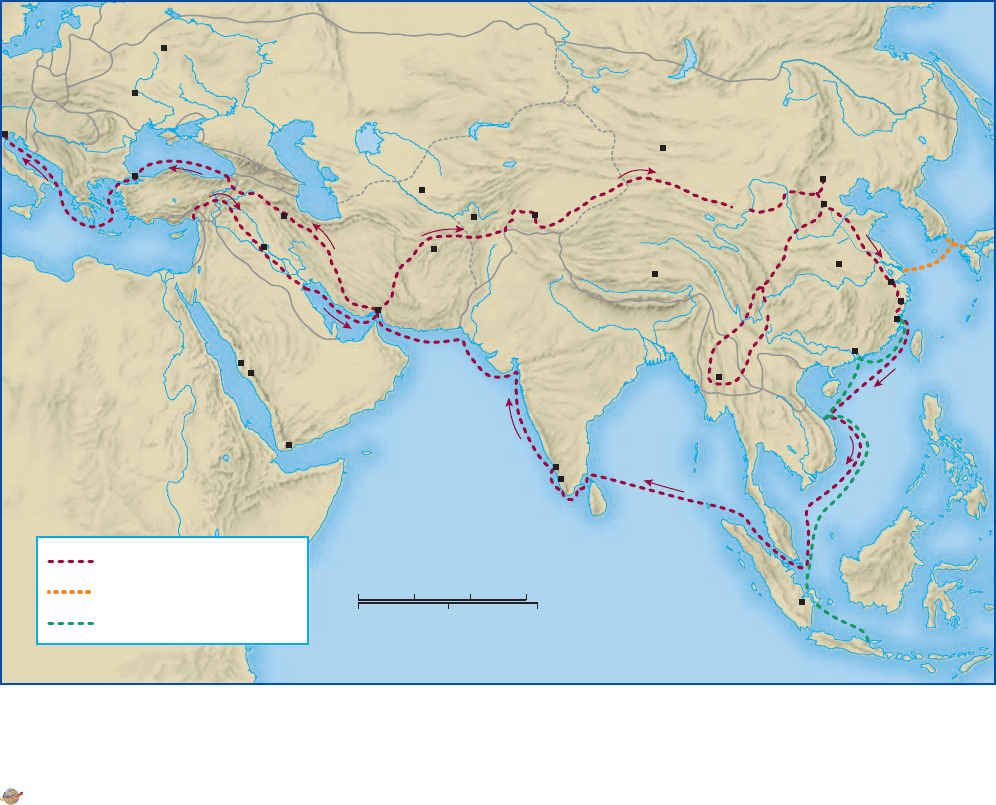
Mongol Rule in China
At first, China’s new rulers exhibited impressive vitality.
Under the leadership of the talented Khubilai Khan, the
Yuan continued to flex their muscles by attempting to
expand their empire. Mongol armies advanced into the
Red River valley and reconquered Vietnam, which had
declared its independence after the fall of the Tang three
hundred years earlier. Mongol fleets were launched against
Malay kingdoms in Java and Sumatra and also against the
islands of Japan. Only the expedition against Vietnam
succeeded, however, and even that success was temporary.
The Vietnamese counterattacked and eventually drove the
Mongols back across the border. The attempted conquest
of Japan was even more disastrous. On one occasion, a
massive storm destroyed the Mongol fleet, killing thou-
sands (see Chapter 11).
The Mongols had more success in governing China.
After a failed attempt to administer their conquest as
they had ruled their own tribal societ y (some advisers
reportedly even suggested that the plowed fields be
transformed into pastures), Mongol rulers adapted to
the Chinese political system and made use of local tal-
ents in the bureaucracy. The tripartite division of the
administration into civilian, military, and censorate was
retained, as were the six minist ries. The civil service
system, which had been abolished in the north in 1237
and in the south for ty years later, was revived in the early
fourteenth century. The state cult of Confucius was also
restored, altho ugh Khubilai Khan himself remained a
Buddhist.
But there were some key differences. Culturally, the
Mongols were nothing like the Chinese and remained a
separate class with its own laws. The highest positions in
Indian
Ocean
C
a
s
p
i
a
n
S
e
a
S
o
u
t
h
e
r
n
S
e
a
Grand
Canal
Y
a
n
g
t
z
e
R
.
Y
e
l
l
o
w
R.
K
e
r
u
l
e
n
R
.
I
n
d
u
s
R.
D
a
n
u
b
e
R
.
Black Sea
V
o
l
g
a
R
.
Arabian
Sea
Bay of
Bengal
N
i
l
e
R.
M
e
d
i
t
e
r
r
a
n
e
a
n
S
e
a
B
r
a
b
m
a
p
u
t
r
a
R
.
KHANATE OF THE
GREAT KHAN
(EAST ASIA)
KHANATE OF KIPCHAK
(GOLDEN HORDE)
KHANATE
OF PERSIA
(IL-KHANS)
KHANATE OF
CHAGHADAI
(ILI)
POLAND
HUNGARY
TEUTONIC
KNIGHTS
BOHEMIA
CAUCASUS
GEORGIA
SYRIA
HOLY
LAND
AFRICA
ARABIA
INDIA
AFGHANISTAN
KASHMIR
SUMATRA
JAVA
BURMA
VIETNAM
JAPAN
SIBERIA
SRI LANKA
MONGOLIA
YUNNAN
WU-T'AI
SHAN
KANSU
NAN-CHAO
MALAY
PENIN.
Coromandel
Coast
KOREA
Venice
Constantinople
Hormuz
Baghdad
Tabriz
Bokhara
Samarkand
Kashgar
Calicut
Cochin
Palembang
Mandalay
Canton
Quanzhou
Fuzhou
Hangzhou
Kaifeng
Khanbaliq
(Beijing)
Shang-tu
Karakorum
Lhasa
Jidda
Mecca
Aden
Herat
Moscow
Kiev
1
2
8
1
1
2
7
4
1
2
9
2
–
1
2
9
3
0 600 1,200 Miles
0 600 1,200 1,800 Kilometers
Routes of Marco Polo
Expeditions against Japan
Route to Java, 1292–1293
MAP 10.2 Asia Under the Mongols. This map traces the expansion of Mongol power
throughout Eurasia in the thirteenth century. After the death of Genghis Khan in 1227,
the empire was divided into four separate khanates.
Q
Wh y was the Mongol Empire divided into four separate khanates?
View an animated version of this map or related maps at www.c engage.com/history/
duikspiel/essentialworld6e
250 CHAPTER 10 THE FLOWERING OF TRADITIONAL CHINA

the bureaucracy were usually staffed by Mongols. Al-
though some leading Mongols followed their ruler in
converting to Buddhism, most commoners retained their
traditional religion. Even those who adopted Buddhism
chose the Lamaist variety from Tibet, which emphasized
divination and magic.
Despite these differences, some historians believe that
the M ongol dynas ty won considerable support from the
majority of the Chinese. The people of the north, after all,
were used to foreign rule, and although those living far-
ther to the south may have resented their alien conquer-
ors, they probably came to respect the stability, unity, and
economic prosperity that the Mongols initially brought to
China.
Indeed, the Mongols’ greatest achievement may
have been the prosperity they fostered. At home, they
continued the relatively tolerant economic policies of
the southern Song, and by bringing the entire Eurasian
landmass under a sing le rule, they encouraged long-
distance trade, par ticularly along the Silk Road, now
dominated by Muslim merchants from Central Asia. To
promote trade, the Grand Canal was extended from the
Yellow River to the capital. Adjacent to the canal, a
paved hig hway was constructed that extended all the
way from the Song capital of Hangzhou to its Mongol
counterpart at Khanbaliq.
The capital was a magnificent city. According to the
Italian merchant Marco Polo, who resided there during
FILM & HISTORY
T
HE ADVENTURES OF MARCO POLO (1938) AND MARCO POLO (2007)
The famous story of Marco Polo’s trip to East Asia
in the late thirteenth century has sparked the imagi-
nation of Western readers ever since. The son of an
Italian merchant from Venice, Polo went to China in
1270 and did not return for twenty-four years, trav-
eling eastward via the Silk Road and returning by
sea across the Indian Ocean. Captured by the Geno-
ese in 1298 and tossed into prison, he recounted his
experiences to a professional writer known as Rusti-
cello of Pisa. Copies of the resulting book, originally
entitled Descr iption of theWorld, were soon circulat-
ing throughout Europe, and one eventually found its
way into the hands of Christopher Columbus, who
used it as a source for information on the eastern
lands he sought during his own travels. Marco Polo’s
adventures have been translated into numerous lan-
guages, thrilling readers around the world, and film-
makers have done their part, producing feature films
that have depicted his exploits to modern audiences.
But did Marco Polo actually visit China, or
was the book an elaborate hoax? In recent years, some historians
have expressed doubts about the verac ity of his account. Frances
Wood, auth or of Did Marco Polo Go to China? (1996), provoked a
lively debate in academic circles with the suggestion that he might
have simply recounted tales that he heard from contemporaries.
Such reservations have not ended popular fascination with Polo’s
exploits, and commercial films on the subject continue to attract
audiences. The first to be produced in Hollywood, The Adventures of
Marco Polo (1938), starred Gary Cooper, with Basil Rathbone as his
evil nemesis in China. Like many film epics of the era, it was highly
entertaining but lacking in historical accuracy. The most recent ver-
sion, a Hallmark Channel production called Mar co Polo, appeared in
2007 and starred the young American actor Ian Somerhalder in the
title role. The film is a reasonably faithful rendition of the book, with
stirring battle scenes, the predictable ‘‘cast of thousands,’’ and a some-
what unlikely love interest between Polo and a Mongol princess
thrown in. Although the lead character is not particularly convincing
in the title role---after two grueling decades in Asia, he still bears a
striking resemblance to a teenage surfing idol---the producers should
be credited for their efforts to portray China as the most advanced
civilization of its day. A number of Chinese inventions then unknown
in Europe, such as paper money, explosives, and the compass, appear
in the film. Emperor Khubilai Khan (played by the veteran actor
Brian Dennehy) does not project an imperial presence, however, and
is unconvincing when he announces that he prefers someone who
speaks the truth to power.
Scene from The Adventures of Marco Polo (1938). Marco Polo (Gary Cooper,
gesturing on the right) confers with Kaidu (Alan Hale), leader of the Mongols.
c
Everett Collection
EXPLOSION IN CENTRAL ASIA:THE MONGOL EMPIRE 251
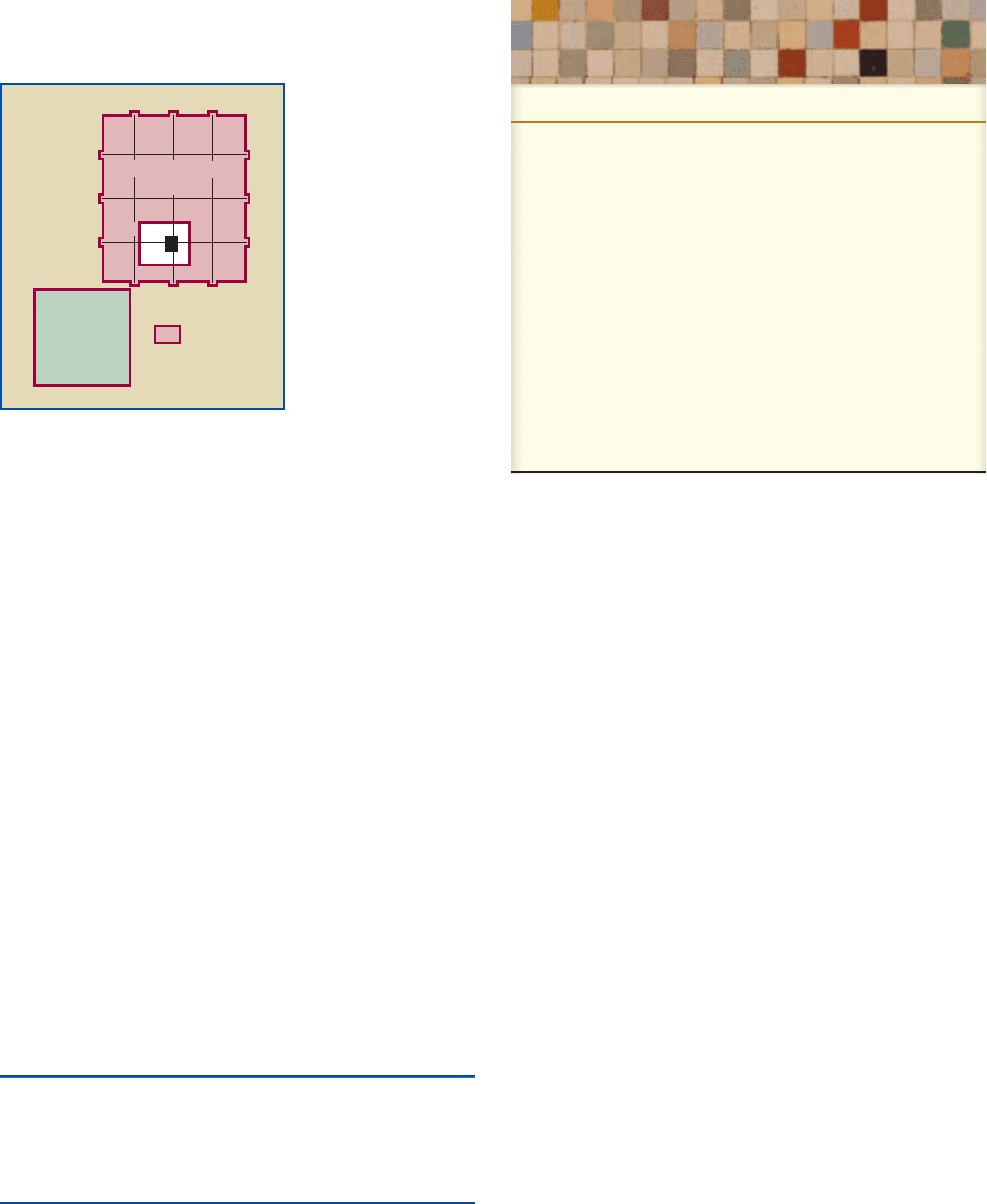
the reign of Khubi-
lai Khan, it was
24 miles in diameter
and surrounded by
thick walls of earth
penetrated b y a
dozen massive gates.
He described the
old Song capital of
Hangzhou as a no-
ble city where ‘‘so
many pleasures may
be found that one
fancies himself to be
in Paradise.’’
From the Yuan to the Ming
But the Yuan eventually fell victim to the same fate that
had afflicted other powerful dynasties in China. Excessive
spending on foreign campaigns, inadequate tax revenues,
factionalism and corruption at court and in the bureau-
cracy, and growing internal instability all contributed to
the dynasty’s demise. Khubilai Khan’s successors lacked
his administrative genius, and by the middle of the
fourteenth century, the Yuan dynasty in China, like the
Mongol khanates elsewhere in Central Asia, had fallen
into a rapid decline.
The immediate instrument of Mongol defeat was
Zhu Yuanzhang (Chu Yuan-chang), the son of a poor
peasant in the lower Yangtze valley. After losing most of
his family in the famine of the 1340s, Zhu became an
itinerant monk and then the leader of a band of bandits.
In the 1360s, unrest spread throughout the country, and
after defeating a number of rivals, Zhu Yuanzhang put an
end to the disintegrating Yuan regime and declared the
foundation of a new Ming (‘‘bright’’) dynasty (which
lasted from 1369 to 1644).
The Ming Dynasty
Q
Focus Questions: What were the chief initiatives taken
by the early rulers of the Ming dynasty to enhance the
role of China in the world? Why did the imperial
court order the famous voyages of Zhenghe, and why
were they discontinued?
The Ming inaugurated a new era of greatness in Chinese
history. Under a series of strong rulers, China extended its
rule into Mongolia and Central Asia. The Ming even
briefly reconquered Vietnam, which, after a thousand
years of Chinese rule, had reclaimed its independence
following the collapse of the Tang dynasty in the tenth
century. Along the northern frontier, the emperor Yongle
(Yung Lo, 1402--1424) strengthened the Great Wall and
pacified the nomadic tribespeople who had troubled
China in previous centuries. A tributary relationship was
established with the Yi dynasty in Korea.
The internal achievements of the Ming were equally
impressive. When they replaced the Mongols in the
fourteenth century, the Ming turned to traditional Con-
fucian institutions as a means of ruling their vast empire.
These included the six ministries at the apex of the bu-
reaucracy, the use of civil service examinations to select
members of the bureaucracy, and the division of the
empire into provinces, districts, and counties. As before,
Chinese villages were relatively autonomous, and local
councils of elders continued to be responsible for adju-
dicating disputes, initiating local construction and irri-
gation projects, mustering a militia, and assessing and
collecting taxes.
The society that was governed by this vast hierarchy
of officials was a far cry from the predominantly agrarian
society that had been ruled by the Han. In the burgeoning
cities near the coast and along the Yangtze River valley,
factories and workshops were vastly increasing the variety
and output of their manufactured goods. The population
had doubled, and new crops had been introduced, greatly
expanding the food output of the empire.
The Voyages of Zhenghe
In 1405, in a splendid display of Ch inese m aritime
might, Yongle sent a fleet of Chinese trading ships under
Imperial City
MONGOL
CITY
NATIVE
CITY
Built
1267–1271
Khanbaliq (Beijing) Und er th e
Mongols
CHRONOLOGY
Medi e va l Ch i n a
Arrival of Buddhism in China c. first century
C.E.
Fall of the Han dynasty 220
C.E.
Sui dynasty 581--618
Tang dynasty 618--907
Li Bo (Li Po) and Du Fu (Tu Fu) 700s
Song dynasty 960--1279
Wang Anshi 1021--1086
Southern Song dynasty 1127--1279
Mongol conquest of China 1279
Reign of Khubilai Khan 1260--1294
Fall of the Yuan dynasty 1368
Ming dynasty 1369--1644
252 CHAPTER 10 THE FLOWERING OF TRADITIONAL CHINA

the eunuch admiral Zhenghe (Cheng Ho) through the
Strait of Malacca and out into the Indi an Ocean; there
they traveled as far west as the east coast of Africa,
stopping on the way at ports in South Asia. The size of
the fleet was impressive: it included nearly 28,000 sailors
on sixty-two ships, some of them junks larger by far
than any other oceangoing vessels the world had yet
seen. Ch ina seemed about to become a direct participant
in the vast trade network that extended as far west as the
Atlantic Ocean, thereby culminating the process of
opening China to the wide r world that had begun with
the Tang dynasty.
Why the expeditions were undertaken has been a
matter of some debate. Some historians assume that
economic profit was the main reason. Others point to
Yongle’s native curiosity and note that the voyage---and
the six others that followed it---returned not only with
goods but also with a plethora of information about the
outside world as well as with some items unknown in
China (the emperor was especially intrigued by the gi-
raffes and installed them in the imperial zoo).
Whatever the case, the voyages resulted in a dramatic
increase in Chinese knowledge about the world and the
nature of ocean travel. They also brought massive profits
for their sponsors, including individuals connected with
Admiral Zhenghe at court. This aroused resentment
among conservatives within the bureaucracy, some of
whom viewed commercial activities with a characteristic
measure of Confucian disdain.
An Inward Turn
Shortly after Yongle ’s death, the vo yages wer e dis-
continued, never to be revived. The decision had long-
term consequences and in the eyes of many modern his-
torians marks a turning inward of the Chinese state, away
The Great Wall of China. Although the Great Wall is popularly
believed to be more than two thousand years old, the part of the wall
that is most frequently visited by tourists today was a reconstruction
undertaken during the early Ming dynasty as a means of protection
against invasion from the north. Part of that wall, which was built to
protect the imperial capital of Beijing, is shown here. The original walls,
which stretched from the shores of the Pacific Ocean to the deserts of
Central Asia, were often composed of loose stone, dirt, or piled rubble.
The section shown on the right is located north of the Turfan Depression
in Xinjiang Province.
c
William J. Duiker
c
William J. Duiker
THE MING DYNASTY 253
